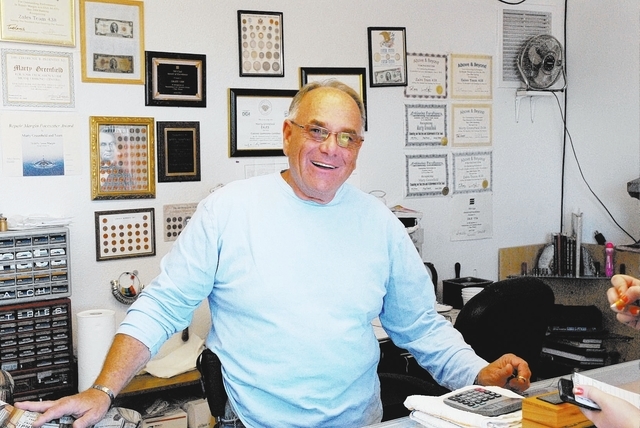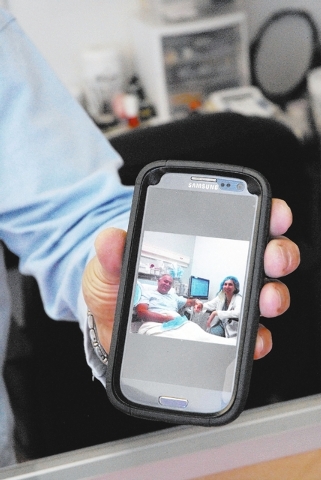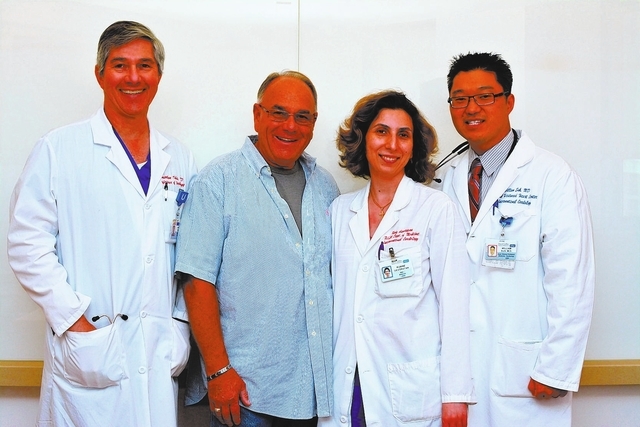A HOPEFUL HEART: Local man part of national stem cell study
Looking at Marty Greenfield you wouldn’t know he’s often in pain.
The local owner of Jewelry and Appraisal Consulting greets customers with a casual smile as they walk through the door of his humble shop each day at its location on Matthew Lane.
But beneath the calm and collected exterior, Greenfield suffers from a painful heart condition known as angina, which is caused by inadequate blood flow to the heart.
Since the age of 41, Greenfield, who is now 64, says he has suffered eight heart attacks and been through three surgeries and around a dozen angiograms as doctors have tried to improve the Pahrump man’s health.
But it wasn’t until the flip of a coin led him to a team of cardiologists at the University of California, Los Angeles, that he was able to successfully participate in a groundbreaking study that may not only help improve Greenfield’s quality of life, but the quality of life for countless others if the procedure proves a success.
Greenfield was entered into Phase III of a clinical trial called RENEW, funded by the Baxter Healthcare Corporation, that uses a patient’s own blood-derived stem cells to try to restore blood circulation to their damaged heart. The trial uses the latest technology to map the heart in 3D and guides doctors to deliver the stem cell injections to targeted sites in the heart muscle.
Dr. William Suh, assistant clinical professor of medicine for the division of cardiology at the David Geffen School of Medicine at UCLA, said Greenfield and other patients who suffer from attacks of angina are often limited in their physical activity.
“Angina is a term that refers to chest pain or discomfort that occurs when the heart muscle does not have enough blood supply and oxygen. It is in a sense the heart’s warning system that there is a problem with blood flow to the heart muscle. In some patients, blockages in the heart arteries can cause a cardiomyopathy, weakening of the heart muscle, and congestive heart failure. Blockages in the arteries can also lead to heart attack. Patients that have angina are limited in their physical activity because exertion will cause chest pain or discomfort. Patients with life debilitating angina can become cardiac cripples,” he said.
If this study is a success, Suh said the results could provide important clinical data to treat millions of Americans at risk of suffering heart attacks and congestive heart failure.
“Stem cell therapy and its clinical applications are still in its infancy. If patients like Marty show that stem cell therapy can improve angina, it would be a huge advance in the stem cell field. Stem cell therapy is also being investigated in patients that have had heart attacks and in patients with congestive heart failure. The clinical implications are huge since morbidity from heart attacks and congestive heart failure affects millions of Americans,” the doctor said.
UCLA is one of 51 medical centers participating in the study throughout the U.S. and Canada.
Greenfield was first directed to the cardiology team at UCLA and this study earlier this year after a cardiologist he was seeing here in Pahrump told him there was nothing else that could be done to treat his condition other than to put him on a waiting list for a heart transplant.
“About a year ago, he put his hands up in the air and said there’s nothing else I can do for you, you need a heart transplant. And I said really? And he said that’s all you’ve got, you have seven blockages or five blockages and you need a heart transplant, it’s about the only thing that will help you and other than that all we can do is keep you stable,” Greenfield said.
“I went into the hospital in January again with chest pains and there was nothing anyone could do because I was in Vegas with it and they were telling me they can’t go in anymore with angiograms because my left side is shutting down more and more and more, and they couldn’t get instruments in there to do stents or anything of any consequence. So they stabilized me and kept me comfortable for five, six days and then I was released from the hospital,” he recalled.
After a cardiologist in Las Vegas gave him the names of two specialists in California, the decision to meet with Dr. Jonathan Tobis and his team at UCLA was decided by flipping a coin. Greenfield said he had no idea at that time the decision to see Tobis would be life changing.
When Greenfield met with Tobis in July, the doctor examined him and after several rounds of testing gave Greenfield the first good news he had heard in some time.
Tobis told Greenfield he would not need a heart transplant after all.
“He took a chance in late June, early July and said I’m going to do an angiogram on you anyhow even though no one else could. And he found he couldn’t get into the side, but he also found out that my muscle was fine, I didn’t need a transplant. It was artery disease; I didn’t need a heart transplant.” And then he called someone who was the coordinator and between the three doctors they approved him for the stem cell research program, Greenfield said. “I never expected that. I was figuring the worst case scenario they would look at the heart and say you need the transplant. As a matter of fact, when we talked, this other doctor up here even mentioned you know you’re going to have to get on the transplant list eventually, and guess what? I didn’t need the transplant.”
Once Greenfield had signed more than two dozen release forms to participate in the study, the doctors at UCLA were ready to begin the process of harvesting Greenfield’s own stem cells for possible injection into his heart.
Suh said before the doctors could go in and harvest Greenfield’s stem cells, they had to put him on a medication called Neupogen to stimulate his bone marrow to produce more white blood cells, which included the necessary stem cells.
Five days later doctors placed a central venous catheter into Greenfield and a process known as apheresis was conducted, which separates the white blood cells from the rest of the blood. Once that process was finished, the white blood cells were sent to a lab where the stem cells were separated, and two days later they were ready to be injected into Greenfield’s heart.
On Oct. 17, Greenfield became UCLA’s first patient to participate in the clinical trial.
Prior to receiving the direct injections of the stem cells, researchers first mapped Greenfield’s heart with colorful 3D images to study both the voltage and motion of the muscle. Damaged areas do not have as high voltage and movement as the undamaged areas.
“We are able to tell by the voltage levels and motion which area of the muscle is scarred or abnormal and not getting enough blood and oxygen,” said Tobis, a clinical professor of cardiology and director of interventional cardiology research for the David Geffen School of Medicine at UCLA and the UCLA Health System. “We then target the injections to the areas just adjacent to the scarred and abnormal heart muscle to try to restore some of the blood flow.”
CD34+ stem cells are pluripotent, meaning they have the capability to turn into other cells. The UCLA team said they hope these cells will either become new and healthy heart muscle cells or, more likely, the cells will stimulate the growth of new blood vessels, a process called angiogenesis.
Those new vessels could provide better blood flow and oxygen to the heart muscle area adjacent to the scarred and abnormal tissue.
While the study is double-blinded, meaning neither the team at UCLA nor Greenfield know if the matter injected into his heart was actually Greenfield’s own stem cells or a placebo, they should find out in 12 months which one he received.
Greenfield said the doctors told him if he was in fact injected with the stem cells, they would expect to see some sort of improvement in the level of blood flow to his heart within the next two to three months.
“What we hope to observe is an improvement in his angina. If stem cells were injected, these cells would promote angiogenesis, development of new blood vessels, to the areas of the heart with diminished blood flow,” Suh said.
According to UCLA, the study seeks to enroll more than 440 patients nationwide, with a three-armed approach involving a double-blinded group of 222 volunteers who will receive the stem cells, 111 volunteers who will be given the placebo and 111 patients who will be treated according to the current Standard of Care. The patients will subsequently be followed for two years.
Whether he is among the group that received the stem cells or not, Greenfield said he is happy to play the guinea pig if it means it can help even one other person suffering from a heart condition similar to his own.
“This is not about me. Everybody has a purpose in life. I may have been the black sheep of the family for a long time, and we’ve all had our issues, but my main reason I was put on this earth, I finally believe, was to get approved for this study at UCLA, and I’m the first candidate that has, so that maybe I can help someone else. That’s my whole reason,” Greenfield said.
That message was made all the more clear to him, he said, after he witnessed a four-month old infant being prepped for heart surgery shortly before going in for a procedure for this study.
“There was a child across the room from me before I was going in for one of the procedures, who was four, five months old and also going in for heart surgery. And I cried my eyes out because I was sitting there going, ‘now I know why I’m here. God put that little girl in front of my eyes to let me know my purpose in life is to go through this study,’ no matter how agonizing it was with the bone marrow being injected to create stuff that was causing me joint pain, stomach pain, nausea, having a catheter stuck in my neck, but it makes no difference. My attitude is that it isn’t about me. After seeing that little girl I knew my attitude was if this procedure and this research can help one other person in humanity that’s all I care about,” he said.
Suh said UCLA currently has three other participants being evaluated for the same study.
“For those patients that are suffering from angina and their doctors have told them that there is nothing that can be done with angioplasty or surgery, there is hope. Participation in these types of trials hopefully will help the individual, but more importantly, their participation can help their fellow mankind as we develop new therapies to treat heart disease,” he said.
To qualify, patients must have tried all anti-anginal FDA approved Standard of Care therapy, unless contraindicated or not tolerated, to treat their chest pain and still continue to be symptomatic. For more information about participating in this study at UCLA, please call 310-794-4797.
















